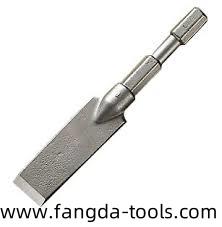Every craftsman begins with a tool that defines precision, and in the world of fine construction, that instrument is the Steel Chisel. At Fangda, the creation of each piece is not merely a matter of production but a story of control over material, geometry, and endurance. A chisel is more than hardened steel—it is the physical expression of how design and discipline intersect in the hands of a maker.
Across workshops, foundries, and construction sites, chisels take countless forms. Each type carries a unique purpose. Cold chisels cut through metal and bolts; stone chisels carve texture and character from granite; wood chisels shape detail and symmetry. The selection of the right form is not about preference but about purpose. The width of the blade, the angle of the bevel, and the balance of the handle all determine how force translates into accuracy. The science of this transformation lies within proportion and resistance—the dialogue between hand and steel.
The making of a chisel begins with alloy selection. Steel must withstand not only compression but the shock of repeated impact. This resilience comes from a specific balance between hardness and ductility, achieved through careful heat treatment and controlled tempering. Each forged blank passes through a sequence of heating and quenching cycles, building internal strength layer by layer. The end result is not simply toughness—it is equilibrium, a state where sharpness meets structural calm.
However, endurance is not born from forging alone. A tool's longevity depends on its care. The sharpening of a chisel is not an act of repair but of renewal. When the blade meets the whetstone, it regains alignment; when oil is applied, it resists corrosion; when stored correctly, it breathes in balance. The subtle art of maintenance transforms a tool from an object into an investment. It teaches patience, rhythm, and awareness of the metal's silent behavior.
Maintenance also reveals a truth often overlooked: the integrity of a chisel mirrors the discipline of its user. Every craftsman who respects his tool understands that its edge is not eternal; it demands attention. A dull chisel forces the hand to exert more pressure, risking both accuracy and safety. Regular sharpening maintains not only performance but control—the very essence of craftsmanship.
Even the handle plays a quiet but significant role. Traditionally made of ash or hickory, it absorbs vibration while transferring energy efficiently. In modern times, engineered polymers have been introduced to improve grip and reduce fatigue. The handle connects the craftsman to the steel, forming an unspoken bond of precision and stability.
The working life of a chisel unfolds like a dialogue between impact and restraint. With every strike, force meets form, and sound meets silence. When the edge slices cleanly through stone or steel, it tells of geometry that has been mastered, of material that has learned obedience. Such perfection is not an accident; it is the outcome of balance—of metal hardened to endure yet shaped to yield.
What defines a great tool is not its appearance but its endurance in motion. A well-forged chisel carries within it a memory of heat, hammer, and patience. It is a story written not in words but in marks left upon metal, wood, or stone.To hold such a tool is to hold the accumulated understanding of craftsmanship itself. In every precise cut lies the whisper of tradition, the persistence of quality, and the elegance of control.From its forging fire to its final polish, each creation by Fangda is made with a vision of strength refined through time. Experience the legacy of craftsmanship through every Steel Chisel at https://www.fangda-tools.com/product/steel-chisels/
